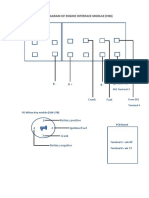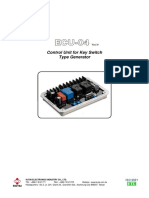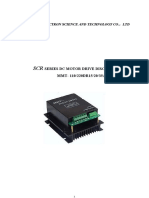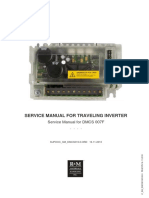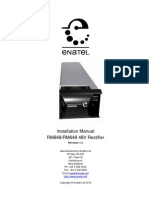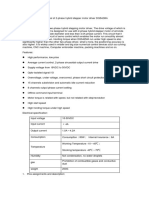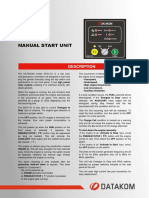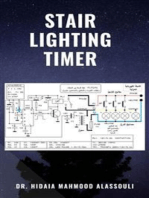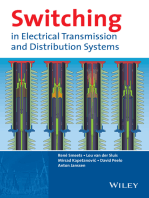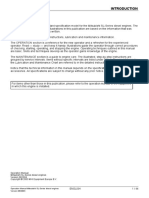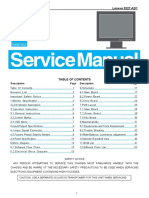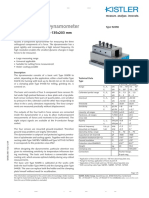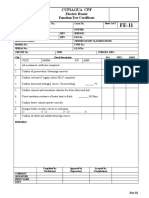Deep Sea Electronics PLC: 701 Key Start Module Operating Instructions
Deep Sea Electronics PLC: 701 Key Start Module Operating Instructions
Uploaded by
osanebiCopyright:
Available Formats
Deep Sea Electronics PLC: 701 Key Start Module Operating Instructions
Deep Sea Electronics PLC: 701 Key Start Module Operating Instructions
Uploaded by
osanebiOriginal Description:
Original Title
Copyright
Available Formats
Share this document
Did you find this document useful?
Is this content inappropriate?
Copyright:
Available Formats
Deep Sea Electronics PLC: 701 Key Start Module Operating Instructions
Deep Sea Electronics PLC: 701 Key Start Module Operating Instructions
Uploaded by
osanebiCopyright:
Available Formats
DEEP SEA ELECTRONICS PLC
701 KEY START MODULE
OPERATING INSTRUCTIONS
Author:- John Ruddock
Deep Sea Electronics Plc
Highfield House
Hunmanby
North Yorkshire
YO14 0PH
England
Tel: +44 (0) 1723 890099
Fax: +44 (0) 1723 893303
email: Sales@Deepseaplc.com
701 Operating Instructions Issue Issue 1 07/05/2003 3:30 PM JR -1-
<< This page is intentionally blank >>
701 Operating Instructions Issue Issue 1 07/05/2003 3:30 PM JR -2-
TABLE OF CONTENTS
1 DESCRIPTION OF OPERATION .......................................................... 4
1.1WARNINGS.......................................................................................................5
1.2SHUTDOWNS ...................................................................................................5
2 CONFIGURATION INSTRUCTIONS..................................................... 6
3 TERMINAL DESCRIPTION................................................................... 7
4 SPECIFICATION ................................................................................... 8
5 SOLID STATE OUTPUTS..................................................................... 9
6 DIMENSIONS ...................................................................................... 10
7 TYPICAL CONNECTIONS.................................................................. 10
701 Operating Instructions Issue Issue 1 07/05/2003 3:30 PM JR -3-
1 DESCRIPTION OF OPERATION
To start the generator turn the key switch to the hand position, which will power up the unit.
If at this time the auxiliary input is active the led will be illuminated, preventing the start of the
generator.
Pressing the pre-heat button will energise the pre-heat output. Releasing the button will de-
energise the output.
Pressing the start button will energise the Fuel Solenoid output, then the Starter Motor
output. The button should be pressed for the duration of the crank period.
When the engine fires, the starter motor is disengaged and locked out at 20 Hz measured from the
Alternator output.
After the starter motor has disengaged, the Safety On timer is activated (which is fixed at 12
seconds), allowing Oil Pressure, High Engine Temperature and Charge Fail to stabilise without
triggering the fault.
Turning the key to STOP de-energises the FUEL SOLENOID, bringing the generator to a stop.
NOTE: - The safety on time (used for delayed alarms) is pre set to 12 seconds and can
not be changed.
NOTE: - If the generator has not started when the start button has been released
or the generator fails once it is running, the key switch must be turned to STOP and
then back to before another start can be invoked.
NOTE: - If pre-heat is required during cranking, the pre-heat button should be
pressed at the same time as the start button.
NOTE: - The 701HC start button is represented by
701 Operating Instructions Issue Issue 1 07/05/2003 3:30 PM JR -4-
1.1 WARNINGS
Warnings are used to warn the operator of an impending fault
BATTERY CHARGE FAILURE, if the module does not detect a voltage from the warning light
terminal on the auxiliary charge alternator, the icon will illuminate.
1.2 SHUTDOWNS
Shutdowns are latching and stop the Generator. The alarm must be cleared, and the fault removed
to reset the module. In the event of a shutdown the appropriate icon will be illuminated
Auxiliary Input, if the auxiliary input is energised an immediate shutdown will occur. The icon
will illuminate.
NOTE: - If the Auxiliary input is used to shutdown the engine, the fault must be cleared
before the unit can be reset and the generator restarted.
LOW OIL PRESSURE, if the module detects that the engine oil pressure has fallen below the low
oil pressure switch setting, after the Safety On timer has expired, a shutdown will occur.
The icon will illuminate.
HIGH ENGINE TEMPERATURE if the module detects that the engine coolant temperature has
exceeded the high engine temperature switch setting, after the Safety On timer has expired, a
shutdown will occur.
The icon will illuminate.
OVERSPEED, if the engine speed exceeds the pre-set trip (14% above the nominal frequency) a
shutdown is initiated. Overspeed is not delayed, it is an immediate shutdown.
The icon will illuminate.
NOTE: - During the start-up sequence the overspeed trip level is extended to 24%
above the normal frequency for the duration of the safety timer to allow an extra trip level
margin. This is used to prevent nuisance tripping on start-up.
NOTE: - The safety on time (used for delayed alarms) is pre set to 12 seconds and can
not be changed.
701 Operating Instructions Issue Issue 1 07/05/2003 3:30 PM JR -5-
2 CONFIGURATION INSTRUCTIONS
The only parameter to be configured is the nominal frequency, either 50 Hz or 60 Hz. The
change is made via a switch which is accessible through a slot in the base of the module, (see
photo)
60Hz-50Hz Switch
60Hz 50Hz
This switch adjusts the over speed trip form 57 Hz to 68 Hz, and over shoot from 62 Hz to 70
Hz.
Model 701 Model 701 HC
701 Operating Instructions Issue Issue 1 07/05/2003 3:30 PM JR -6-
3 TERMINAL DESCRIPTION
PIN DESCRIPTION CABLE NOTES
No SIZE
1 DC Plant Supply Input 1.0mm Connected to plant battery negative
(-ve)
2 DC Plant Supply Input 1.0mm Connected to plant battery positive
(+ve) (Recommended Fuse 2A)
3 Fuel relay Output 1.0mm Used to operate the fuel relay.
4 Start relay Output 1.0mm Used to operate the cranking relay.
5 Pre-Heat Output 1.0mm Used to operate the pre heaters. E.g. glow
plugs
6 Auxiliary Input Shutdown 1.0mm Switch to negative.
7 Charge Fail Input/ Excitation 1.0mm Must NOT be connected to plant supply
Output negative if not used.
8 Low Oil Pressure Input 0.5mm Switch to negative.
9 High Engine Temp Input 0.5mm Switch to negative.
10 Alternator Input N 1.0mm Connect to Generator Neutral (AC).
11 Alternator Input L1 1.0mm Connect to Generator L1 supply (AC)
(Recommend 2A Fuse Max.)
NOTE:- All the outputs are solid state, rated at 1.2 Amps 8 Volts to 35 Volts DC, and
switch to battery negative when active.
701 Operating Instructions Issue Issue 1 07/05/2003 3:30 PM JR -7-
4 SPECIFICATION
DC Supply: 8 Volts to 35 Volts DC Continuous.
Cranking Dropouts: Able to survive 0 Volts for 50 mS, providing supply was at
least 10 V before dropout and supply recovers to 5 Volts.
This is achieved without the need for internal batteries.
Max. Current: Operating 9mA
In Off Mode 0mA
Hours Counter (701 HC only) 0 99,999.9 Hours. Tamper Proof
Alternator Input Range: 15 Volts (ph-N) to 305 Volts (ph-N) AC (+20%)
Alternator Input Frequency: 50 - 60 Hz at rated engine speed
(Minimum: 75V AC Ph-N)
(Crank Disconnect from 15V Ph-N @ 20Hz)
Overspeed +14% (+24% overshoot)
Start Output: 1.2 Amp DC at supply voltage.
Fuel Output: 1.2 Amp DC at supply voltage.
Pre Heat: 1.2 Amp DC at supply voltage.
Charge Fail: 3 Volts
Operating Temperature Range: -30C to + 700C
Applicable Standards Compliant with BS EN 60950 Low Voltage Directive
Compliant with BS EN 50081-2: 1992 EMC Directive
Compliant with BS EN 61000-6-4: 2000 EMC Directive
Compliance to European Legislation
Registered Component for USA & Canada
Deep Sea Electronics plc reserve the right to change specification without notice.
701 Operating Instructions Issue Issue 1 07/05/2003 3:30 PM JR -8-
5 SOLID STATE OUTPUTS
DSEs utilisation of Solid State Outputs gives many advantages, the main points being:
No Moving Parts
Fully Overload / Short Circuit Protected.
Smaller dimensions hence lighter, thinner and cheaper than conventional relays.
Less power required making them far more reliable.
The main difference from conventional outputs is that solid state outputs switch to negative (ve)
when active. This type of output is normally used with an automotive or plug in relay.
TYPICAL CONNECTIONS
Solid state output from DSE module
Fuel Solenoid (+ terminal)
eg. Terminal 3 of 701 - FUEL
A D
* Observe polarity when using B C
relays fitted with integral diodes!
Battery positive (+)
Solid State Output Automotive 8 Pin Plugin relay Function
from DSE Module Pin relay Pin
A 3 86 7 Fuel Output
B 85 2 To Positive supply via fuse
C 30 1 To Positive supply via fuse
D 87 3 To Fuel Solenoid
Example of relay pins connected to DSE solid state output to drive a fuel solenoid.
See overleaf for overall typical wiring diagram
701 Operating Instructions Issue Issue 1 07/05/2003 3:30 PM JR -9-
6 DIMENSIONS
701 701HC
Dimensions: Excluding Key Dimensions: Excluding Key
72mm x 72mm x 38mm 84mm x 72mm x 34.9mm
(2.83 x 2.83 x 1.32) (3.3 x 2.8 x 1.4)
Panel cutout: Panel cutout:
68mm x 68mm 80mm x 68mm
(2.68 x 2.68) (3.14 x 2.67)
Mounting Method: Mounting Method:
2 x Fixing Clips (Supplied). 2 x Fixing Clips (Supplied).
7 TYPICAL CONNECTIONS
L1
Alternator
N
F 2A
10 11
SSO = Solid state outputs
Pre-heat output
SSO SSO SSO
1 2 4 3 7 8 9 6 5
Low oil pressure switch
Engine temp switch
Aux shutdown
+ +
F 2A
Crank + Fuel
Starter
motor
To fused Plant Supply +ve
Charge
Battery alt.
= External 'Automotive' or 'Plug-in' type relays
Battery negative should be grounded
Terminals suitable for 22-16 awg (0.6mm2-1.3mm2 )field wiring
Tightening Torque = 0.8N-m (7lb-in)
701 Operating Instructions Issue Issue 1 07/05/2003 3:30 PM JR - 10 -
<< This page is intentionally blank >>
701 Operating Instructions Issue Issue 1 07/05/2003 3:30 PM JR - 11 -
You might also like
- EIM Engine Interface ModuleDocument1 pageEIM Engine Interface Moduleosanebi100% (5)
- Kipor Diesel Generator KDE7000T - EN - PDFDocument20 pagesKipor Diesel Generator KDE7000T - EN - PDFosanebi57% (7)
- Power Failure Backup CompletoDocument93 pagesPower Failure Backup CompletoBrentilda100% (1)
- TECO GS510 ManualDocument52 pagesTECO GS510 ManualMr.K ch75% (4)
- Specifications of Avr - SMR (Mosfet)Document4 pagesSpecifications of Avr - SMR (Mosfet)Александр Щеблыкин50% (2)
- C640D5Document4 pagesC640D5mohsen_cumminsNo ratings yet
- Newage MX341 Automatic Voltage Regulator PDFDocument6 pagesNewage MX341 Automatic Voltage Regulator PDFosanebi100% (3)
- Lenovo IdeaPad S10-3c Hardware Maintenance Manual ServiceDocument88 pagesLenovo IdeaPad S10-3c Hardware Maintenance Manual ServiceYury KobzarNo ratings yet
- Module Content: Unit of Competency: Install PV System Module Title: Installing PV System Module DescriptorDocument33 pagesModule Content: Unit of Competency: Install PV System Module Title: Installing PV System Module DescriptorJohn Rey Alaza100% (2)
- 701 Key Start Module Operating Instructions: Author:-John RuddockDocument11 pages701 Key Start Module Operating Instructions: Author:-John RuddockAmir MohammedNo ratings yet
- Manual de Operación Deepsea DSE702Document21 pagesManual de Operación Deepsea DSE702Carlos Andrés Marín ArcosNo ratings yet
- Deep Sea Electronics PLC: 702 Automatic Start Module Operating InstructionsDocument10 pagesDeep Sea Electronics PLC: 702 Automatic Start Module Operating InstructionsAmborsius Sitorus100% (1)
- Dkg-205 Automatic Mains Failure UnitDocument20 pagesDkg-205 Automatic Mains Failure UnitRafatNo ratings yet
- 205 UserDocument18 pages205 UserAbukar Ali MahdiNo ratings yet
- Datasheet - M542H Stepper Motor DriverDocument10 pagesDatasheet - M542H Stepper Motor DriversthollanderNo ratings yet
- TB6600 User Guide V1 2 PDFDocument11 pagesTB6600 User Guide V1 2 PDFHorvath StefanNo ratings yet
- Manual Soft Starter PSD370 5309699-1Document22 pagesManual Soft Starter PSD370 5309699-1Marcos AldrovandiNo ratings yet
- Ecu 04 Manual enDocument4 pagesEcu 04 Manual enMahendra PersonnelNo ratings yet
- DKG 114 User PDFDocument9 pagesDKG 114 User PDFangel aguilarNo ratings yet
- Emko ATS10 Eng Short v00 PDFDocument6 pagesEmko ATS10 Eng Short v00 PDFCarmen Serbanoiu33% (3)
- Changzhou Wantai Electrical Appliance Co.,LtdDocument10 pagesChangzhou Wantai Electrical Appliance Co.,LtdRaul Giraldo AyalaNo ratings yet
- Frequency Inverter Installation & User Guide: Power 1100, Power 2200Document8 pagesFrequency Inverter Installation & User Guide: Power 1100, Power 2200Ahmed TahaNo ratings yet
- Operating Manual: HGM1750 Automatic Generator ModuleDocument11 pagesOperating Manual: HGM1750 Automatic Generator ModuleMiguel Angel Pavon CarbonellNo ratings yet
- KA KR Motor Driver ManualDocument33 pagesKA KR Motor Driver Manualalexandr.vl.smk2No ratings yet
- Hyundai Elantra 1.6 Engine Electrical1Document55 pagesHyundai Elantra 1.6 Engine Electrical1MANUALES2000CLNo ratings yet
- SmartGen HAT310 120 VAC - PHN - 13 Phase 5060Hz User ManualDocument12 pagesSmartGen HAT310 120 VAC - PHN - 13 Phase 5060Hz User ManualEder MauroNo ratings yet
- Stepper Motor Driver Dm860aDocument6 pagesStepper Motor Driver Dm860achomikNo ratings yet
- DQ542MA English Manual PDFDocument6 pagesDQ542MA English Manual PDFSteven MillerNo ratings yet
- Description: Deep Sea Electronics PLC Manual StartDocument2 pagesDescription: Deep Sea Electronics PLC Manual StartJoel Khamala KarokiNo ratings yet
- R220 Manual Macfarlane GeneratorsDocument7 pagesR220 Manual Macfarlane Generatorsabuzer1981No ratings yet
- P5-80-N1 ManualDocument16 pagesP5-80-N1 ManualVirexManNo ratings yet
- Manual Driver de CorrientrDocument8 pagesManual Driver de CorrientrRonald Sarzuri VargasNo ratings yet
- Variador Yanwa AcerosDocument9 pagesVariador Yanwa Acerosjuan Carlos GonzalezNo ratings yet
- Dq860ma PDFDocument7 pagesDq860ma PDFTrentoNo ratings yet
- CW5045Document5 pagesCW5045raindancer5432No ratings yet
- DQ542MADocument5 pagesDQ542MADima RedkinNo ratings yet
- Controlador de CorrienteDocument12 pagesControlador de Corrientecjaziel66No ratings yet
- Manual Controlador GSC ES52Document24 pagesManual Controlador GSC ES52Jholbert PérezNo ratings yet
- F 171Document115 pagesF 171Michael Parohinog Gregas100% (1)
- Remote Start Unit: DescriptionDocument2 pagesRemote Start Unit: Descriptionemad alsarhanNo ratings yet
- Dkg-105 Automatic Mains Failure UnitDocument12 pagesDkg-105 Automatic Mains Failure Uniteng_moh04No ratings yet
- CMXC 007 Service Manual 003038-9Document9 pagesCMXC 007 Service Manual 003038-9Siding BarroNo ratings yet
- Manual RM648-848 Enatelv1.2Document13 pagesManual RM648-848 Enatelv1.2TRỊNH VĂN THIỆN100% (1)
- TB6600 User GuideDocument11 pagesTB6600 User GuideRudyardo MartinezNo ratings yet
- Auto Start: DescriptionDocument2 pagesAuto Start: DescriptionmohammedalathwaryNo ratings yet
- Contador Hanyoung GE4Document4 pagesContador Hanyoung GE4Juan Felipe Vieira Gaviria0% (1)
- Manual L510Document102 pagesManual L510JoseManuelNuñezNo ratings yet
- 71gxAVlP MLDocument6 pages71gxAVlP MLVikas KumarNo ratings yet
- 中文 English Deutsch Pусский язык: Home Page About us Products News Services Contact usDocument15 pages中文 English Deutsch Pусский язык: Home Page About us Products News Services Contact usHOLDORFNo ratings yet
- SU-KAM Cosmic - 800-1400VA ManualDocument13 pagesSU-KAM Cosmic - 800-1400VA ManualchkarthiksaiNo ratings yet
- STK681-210-E: Forward/Reverse Motor DriverDocument0 pagesSTK681-210-E: Forward/Reverse Motor Driverfredy51No ratings yet
- Advr 16 Manual enDocument6 pagesAdvr 16 Manual enabuzer1981No ratings yet
- Manual Start Unit: DescriptionDocument2 pagesManual Start Unit: DescriptionHaider HameedNo ratings yet
- Panasonic Pt-Ew540 Ew540l Ew540d Ew540ld Pt-Ex510 Ex510l Ex510d Ex510ld SMDocument125 pagesPanasonic Pt-Ew540 Ew540l Ew540d Ew540ld Pt-Ex510 Ex510l Ex510d Ex510ld SMTung NguyenNo ratings yet
- Especificaciones Tecnicas Deep Sea 501 - EspañolDocument2 pagesEspecificaciones Tecnicas Deep Sea 501 - EspañolMH..2023No ratings yet
- Axpert Max7.2K Service Manual 20210615Document29 pagesAxpert Max7.2K Service Manual 20210615fritzzag100% (1)
- 706MKIIG Service Manual 2007Document67 pages706MKIIG Service Manual 2007saulNo ratings yet
- Manual of Cdig-310220Document22 pagesManual of Cdig-310220trinath mohapatraNo ratings yet
- Newage Sx440 Automatic Voltage RegulatorDocument4 pagesNewage Sx440 Automatic Voltage Regulatorsantofrty100% (3)
- Reference Guide To Useful Electronic Circuits And Circuit Design Techniques - Part 2From EverandReference Guide To Useful Electronic Circuits And Circuit Design Techniques - Part 2No ratings yet
- Analog Dialogue, Volume 48, Number 1: Analog Dialogue, #13From EverandAnalog Dialogue, Volume 48, Number 1: Analog Dialogue, #13Rating: 4 out of 5 stars4/5 (1)
- Reference Guide To Useful Electronic Circuits And Circuit Design Techniques - Part 1From EverandReference Guide To Useful Electronic Circuits And Circuit Design Techniques - Part 1Rating: 2.5 out of 5 stars2.5/5 (3)
- Influence of System Parameters Using Fuse Protection of Regenerative DC DrivesFrom EverandInfluence of System Parameters Using Fuse Protection of Regenerative DC DrivesNo ratings yet
- Winpower Standby Troubleshooting GuideDocument4 pagesWinpower Standby Troubleshooting GuideosanebiNo ratings yet
- Transformers9 21 11 PDFDocument16 pagesTransformers9 21 11 PDFosanebiNo ratings yet
- VDO Fuel Level Sensor PDFDocument1 pageVDO Fuel Level Sensor PDFosanebiNo ratings yet
- General Purpose Relay PDFDocument16 pagesGeneral Purpose Relay PDFosanebiNo ratings yet
- Oil Pressure Sensor Product ListDocument10 pagesOil Pressure Sensor Product ListosanebiNo ratings yet
- Cew 035Document1 pageCew 035osanebiNo ratings yet
- Operation Manual Mitsubishi SL-Series Diesel Engines Version 08/2004Document44 pagesOperation Manual Mitsubishi SL-Series Diesel Engines Version 08/2004osanebiNo ratings yet
- Lecture 8 BECDocument14 pagesLecture 8 BECABNo ratings yet
- WEG MPW Motor Protection - WebDocument52 pagesWEG MPW Motor Protection - WebOlivier GalletNo ratings yet
- Q10 Manual 1.4ENDocument10 pagesQ10 Manual 1.4ENAudio Visual Hire CompanyNo ratings yet
- Drawing MDB SMDB PDFDocument32 pagesDrawing MDB SMDB PDFjaimonjoyNo ratings yet
- Applied For:: Objec VeDocument3 pagesApplied For:: Objec VeabiazizNo ratings yet
- Kaqy214 OptoDocument12 pagesKaqy214 OptoKABOOPATHINo ratings yet
- LG 14fk3rb - l2 - Chasis Mc-059dDocument17 pagesLG 14fk3rb - l2 - Chasis Mc-059daries2010mx100% (3)
- Elna (Radial Thru-Hole) ROS SeriesDocument1 pageElna (Radial Thru-Hole) ROS Seriesjghjkhgkh87No ratings yet
- JVC rc-st3sl SMDocument25 pagesJVC rc-st3sl SMAlexBravoNo ratings yet
- Lenovo l171 9227-Ad1 Monitor SMDocument56 pagesLenovo l171 9227-Ad1 Monitor SMMatias SanabriaNo ratings yet
- 000 152e 12.09Document5 pages000 152e 12.09Sedin MurticNo ratings yet
- Grundfosliterature Sqflex enDocument46 pagesGrundfosliterature Sqflex enSINES France67% (3)
- The Mcgraw-Hill Companies, Inc. Permission Required For Reproduction or DisplayDocument14 pagesThe Mcgraw-Hill Companies, Inc. Permission Required For Reproduction or DisplaypsdantonioNo ratings yet
- Parallel Transformers by Circulating Current MethodDocument16 pagesParallel Transformers by Circulating Current MethodDamjan Sculac100% (1)
- Ramsey Barometer UP24B Manual PDFDocument41 pagesRamsey Barometer UP24B Manual PDFJohn100% (1)
- Experiment 4: To Demonstrate Kirchhoff's Voltage Law & Current LawDocument11 pagesExperiment 4: To Demonstrate Kirchhoff's Voltage Law & Current LawNomi AliNo ratings yet
- Stepper Motors Catalog en-US RevADocument146 pagesStepper Motors Catalog en-US RevAYazeed MomaniNo ratings yet
- Hybrid Electric VehicleDocument17 pagesHybrid Electric VehicleEEE_ProceedingsNo ratings yet
- P66 Series Electronic Fan Speed ControlsDocument12 pagesP66 Series Electronic Fan Speed ControlsGrabrielht CrespoNo ratings yet
- Me411 PhotovoltaicsDocument20 pagesMe411 PhotovoltaicskudanyamuNo ratings yet
- Multiband Ret - Jay Beam Antenna1Document21 pagesMultiband Ret - Jay Beam Antenna1mahdin1889No ratings yet
- Lecture 3.2 RL CIRCUIT JottedDocument20 pagesLecture 3.2 RL CIRCUIT JottedMuhd Darwish Mohd ZailaniNo ratings yet
- Stamford PMG Pi14f AscotDocument10 pagesStamford PMG Pi14f AscotJan AhmedNo ratings yet
- CGPDTM Mains Previous Year Papers PhysicsDocument6 pagesCGPDTM Mains Previous Year Papers PhysicsArvind sharma100% (1)
- KT 664Document2 pagesKT 664saratkumarbnNo ratings yet
- MD69BR MA v06r01Document36 pagesMD69BR MA v06r01YOUSSEF ABDELSALAMNo ratings yet
- Cupiagua CPF: Electric Heater Function Test CertificateDocument1 pageCupiagua CPF: Electric Heater Function Test CertificateKhaled FatnassiNo ratings yet
